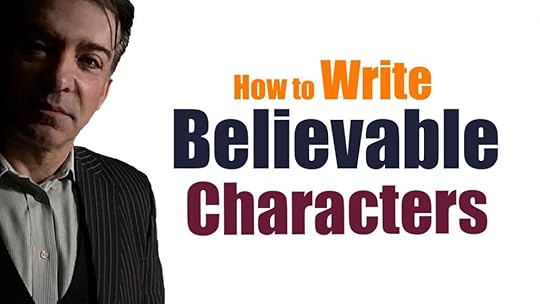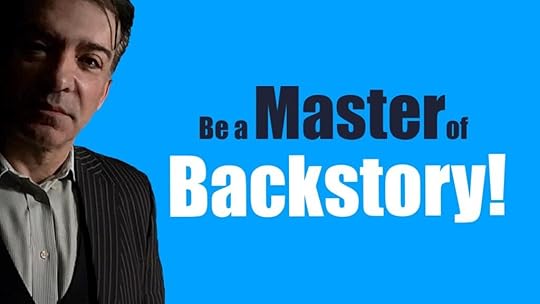Stavros Halvatzis's Blog, page 11
March 12, 2022
Significant action or dialogue?
 The film delivers the story more through small but significant action than dialogue.
The film delivers the story more through small but significant action than dialogue.DIALOGUE, like significant action, is a crucial part of the writer’s toolkit. It promotes the plot, and, at its best, draws us into the inner life of the characters.
Sometimes, however, scenes are better served through action alone.
Who can forget the laconic Spaghetti Westerns featuring Clint Eastward as the cigar chewing, dead calm, gunslinger whose draw is faster than lightning? As he faces man after man, daring each to draw, the tension is conveyed through the biting down on cigars, through unflinching gazes, and through twitching fingers hovering above holstered guns. No need for dialogue here.
In 2001: A Space Odyssey the pervasive feeling of awe at the trajectory of intelligence from ape to spacefaring humanity is conveyed through the silent appearance of the featureless Monolith. Its presence at key moments of evolutionary history creates a depth and gravitas in the minds of the audience that is ineffable.
“Deciding whether to favour dialogue or significant action in a story is, more often than not, a stylistic choice.”Some of the most seemingly innocuous, yet telling moments that reveal character, come from Martin Scorsese’s Taxi Driver where Travis’ (Robert De Niro) silent, sardonic smile, suggests that he is disconnected from the world better than any words can.
When a pimp, played by Harvey Keitel, tries to have a locker-room conversation with him regarding the hiring of one of his girls (Jody Foster), Travis can only stare silently at him, refusing to participate in the verbal banter.
Some stories, of course, are predisposed to character action without dialogue. In war or action films the power mostly comes from the relentless movement of men and equipment, where the only sounds are those of exploding shells, small arms fire, or thundering car and truck engines – Saving Private Ryan, the Mad Max films, Apocalypse Now, Fast and Furious, and countless of others.
Sometimes words seem to mock their very presence in a scene, becoming placeholders for that which cannot be expressed – mysterious, indecipherable, perhaps even an obstacle to meaning itself.
Remember the confusion arising out of Jack Nicholson’s indecipherable utterance in the last moments of Chinatown as he walks away from the crime scene, prompting the lieutenant to ask him repeatedly what he said? Neither the lieutenant nor the audience ever get to hear the answer to that.
Summary
The absence of dialogue often adds power to scenes by shifting the focus on significant action.
Catch my latest YouTube video through this link.

Tweet
The post Significant action or dialogue? appeared first on Stavros Halvatzis Ph.D..
March 5, 2022
Plot types in stories
 Plot types. The Shawshank Redemption is one of many examples of the escape type.
Plot types. The Shawshank Redemption is one of many examples of the escape type.HOW many plot types are there in stories? Here are some suggestions to get you going.
1. The Escape: The protagonist, usually innocent of the crime or accusation, is imprisoned against his will. The plot charts the protagonist’s journey from capture, thwarted attempts to escape, and the final get-away: Escape Plan, The Shawshank Redemption.
2. The Rescue: The protagonist has to rescue the victim from the antagonist by following her to the ends of the earth if needs be: Taken.
3. The Redemption: The hero has to free himself from the internal and external consequences of a past action through atonement. This usually involves gaining insight about his past through a series of increasingly challenging actions: The Nostalgia of Time Travel, Atonement.
4. The Quest: The protagonist goes on a journey to acquire or protect something of great value. The story usually describes the character’s vicissitudes and ultimate growth during this journey: Lord of the Rings.
5. The Temptation: This type of plot explores the concept of morality and exposes the effect of giving in to temptation. It usually involves the Hero resisting temptation, giving in to temptation, suffering the consequences of temptation, and finally achieving some sort of insight, growth and redemption through a sacrificial act: Dangerous Liaisons.
6. The Revenge/Payback: The protagonist assumes the moral high ground by invoking an-eye-for-an-eye vengeance for a great wrong perpetrated by the antagonist: Unforgiven, The Count of Monte Christo.
7. The Rival: The Hero and antagonist are locked in together in a struggle to achieve dominance over a situation or person: Face Off.
“What plot types drive your stories?”8. The Adventure: The Hero travels to exotic lands and experiences extraordinary events—typically in search of some sort of treasure, but ends up gaining true love instead/as well: Raiders of the Lost Arc.
9. The Underdog: Here the protagonist is seriously outgunned in his life-and-death struggle with the antagonist. The antagonist need not be a person. It can be a force of nature which threatens the life of the protagonist. Deep Impact, Twister.
10. The Heist: This involves the identification and setting-up of a target to rob, the execution, the unravelling, and the resolution: The Great Train Robbery, Ocean’s Eleven.
11. The Riddle: This story type sets up a difficult question, mystery, or puzzle as the driving force behind the story. It invites us to find the solution before the Hero does. Solving the puzzle requires that the protagonist use his wits and ingenuity to overcome physical as well as mental obstacles, involving self-sacrifice and the threat of death: Sherlock Holmes.
12. The Chase: In this type of plot the pursuit drives the events and character relationships. For tension to be maintained the chaser(s) must have a reasonable chance of catching the chased: World War Z, The Fugitive.
Summary
Plot types help you write your story by setting up certain requirements and expectations. This article suggests twelve such types.
Catch my latest youtube video here.

Tweet
The post Plot types in stories appeared first on Stavros Halvatzis Ph.D..
February 26, 2022
Have your audiences and readers feel emotion

If we don’t feel emotion for our characters then we won’t care about their stories. And if we don’t care about their stories we won’t care about the ideas they espouse.
This is simple to understand but difficult to achieve.
Simple, because if we come to feel for the characters in a story we will come to care about their fate, and the overarching meaning of the tale. Difficult, because it takes great skill to find the right words to pull this off.
“Emotion shines a light on ignorance and prejudice. It helps uncover the truth hiding behind character action.”Primarily interested in communicating lofty, existential, philosophical concepts about the nature of reality and the human condition? Then write an article for a philosophy or psychology journal. Don’t focus solely on turning your characters into vehicles for conveying ideas. If you do, you will lessen their impact on readers and audiences.
Emotion that supports profound insight, however, makes a story unforgettable. Consider the following passages:
“Leaning against my father, the sadness finally broke open inside me, hollowing out my heart and leaving me bleeding. My feet felt rooted in the dirt. There were more than two bodies buried here. Pieces of me that I didn’t even know were under the ground. Pieces of dad, too.” ― Laurie Halse Anderson, The Impossible Knife of Memory.
”For a moment the world seems balanced on the edge of love and hate—but only for a moment, for how can I ever forget the timeless chats under the stars sitting on my father’s knee, the rocket ships rendered out of wood and paint punching through the golden light of endless afternoons, the stories read to me with such care and patience by my mother whose warm breath I’d feel against my cheek?” —Stavros Halvatzis, The Nostalgia of Time Travel.
“Have you ever wondered what a human life is worth? That morning, my brother’s was worth a pocket watch.” ― Ruta Sepetys, Between Shades of Gray.
“Sometimes pain is so unmanageable that the idea of spending another day with it seems impossible. Other times pain acts as a compass to help you through the messier tunnels of growing up. But pain can only help you find happiness if you remember it.”
― Adam Silvera, More Happy Than Not.
Moving, insightful, stuff and a reminder to writers that insight and emotion go hand in hand.
Summary
If your readers and audiences feel emotion in the stories you write, they will care about the characters and ideas you espouse.
Catch my latest youtube video by clicking on this link.

Tweet
The post Have your audiences and readers feel emotion appeared first on Stavros Halvatzis Ph.D..
February 19, 2022
Improbable action? How to render it believable.
 Interstellar – making improbable action seem believable.
Interstellar – making improbable action seem believable.How do you make improbable action appear believable?
In his book, Film Scriptwriting: A Practical Manual, Dwight V. Swain offers us two principles that underpin verisimilitude in stories – justification for everything that happens in the tale and a proportional response from the character to the events that confront him.
Justification boils down to the readers and audiences believing that given a specific personality type, a character would react to a challenge, to any sort of stimulus really, precisely in the way that he does. In short, if your readers understand why your character acts in a specific way, they will experience his or her actions as believable and appropriate.
But it is also important to render a character’s actions in proportion to the stimulus that initiates them.
“Improbable action can be made probable by having it spring from the twin launchpads of justifiability and proportional response.”
Exaggerated, unmotivated behaviour, under normal circumstances, can spoil a scene. If a girl turns down a casual request for a date from a man she hardly knows and he then proceeds to burst into tears, his behavior would be considered an overreaction.
If, on the other hand, a child were to run into a room, screaming and bleeding, and her mother were to ignore her in order to finish her bridge game, we would consider her behaviour as an underreaction.
Over and under reactions are major flaws that undermine believability in stories.
In interstellar, the earth is dying. Humanity needs to find another home. Cooper, a conscientious, widowed engineer and former NASA pilot turned farmer, lives on a farm with his father-in-law, his 15-year-old son, and his 10-year-old daughter, Murphy.
After a dust storm, strange patterns appear in the dust in Murphy’s bedroom. Cooper realises the patterns were caused by gravity fluctuations that represent geographic coordinates in binary code.
Cooper follows the coordinates to a secret NASA facility headed by Professor John Brand, where he learns of the existence of a wormhole. When he is re-recruited by NASA to fly a mission through the wormhole to confirm the planet most suitable for mankind’s survival, he promises his distraught daughter that he will come back at any cost. This promise creates the motivational spine of the story. It helps Cooper’s actions to appear both justifiable and proportionate, despite the improbable nature of events in the story. It does this by balancing his duty to humanity with his unbreakable promise to his child.
Summary
Improbable character action can be rendered believable by making it justifiable and proportional to the events that initiate it.
Watch my latest youtube video on Pivotal Characters through this link!

Tweet
The post Improbable action? How to render it believable. appeared first on Stavros Halvatzis Ph.D..
February 12, 2022
Evoke emotion if you want your stories to succeed.
 Being able to evoke emotion is a must for masterful writing.
Being able to evoke emotion is a must for masterful writing.In her book, The Novelist’s Guide, Margret Geraghty reminds us that the ability to evoke emotion around the characters in the stories we write is the single most important skill to master. Here’s an extract from Katherine Mansfield’s, The Fly, that does just that.
A fly has fallen into an ink pot and can’t get out. The other character, referred to only as the boss, watches it struggle with glee.
“Help! Help! said those struggling legs. But the sides of the ink pot were wet and slippery; it fell back again and began to swim. The boss took up a pen, picked up the fly out of the ink, and shook it on a piece of blotting paper. For a fraction of a second, it lay still on the dark patch that oozed around it. Then the front legs waved, took hold, and, pulling its small, sodden body up, it began the immense task of cleaning the ink from its wings … it succeeded at last, and, sitting down, it began, like a minute cat, to clean its face. Now one could imagine that the little front legs rubbed against each other, lightly, joyfully. The horrible danger was over; it had escaped; it was ready for life again.
“Learn to evoke emotion through your characters. It is one of the keys to successful writing.”But then, the boss had an idea. He plunged the pen back into the ink, leaned his thick wrist on the blotting paper, and, as the fly tried its wings, down came a heavy blot. What would it make if that? The little beggar seemed absolutely cowed, stunned, and afraid to move because of what would happen next. But then, as if painfully, it dragged itself froward. The front legs waved, caught hold, and more slowly this time, the task began from the beginning.”
This goes on until the fly is dead. If we can feel compassion for a fly, imagine what we can feel for animals and humans.
The writer may often amplify an emotion by providing new information to the reader but hide it from a character who may not yet understand it, such as a child. In my novella, The Nostalgia of Time Travel, I use this technique subtly to suggest a sense of unease in the relationship between a mother and her brother-in-law, as experienced through the sensibility of a child:
“One hot afternoon, my father’s older brother, Fanos, a mechanic with the merchant Greek navy, sailed into our lives, without warning, like a bottle washing out to shore. He carried a small black suitcase in his right hand. The hand was stained by a faded blue tattoo of an anchor that started at the wrist and ended at the knuckles. I found myself staring at it at every opportunity.
Would it be fine if he stayed with us for several days, while his ship underwent repairs at the port of Piraeus, he wanted to know?
My father, who seemed both pained and glad to see him, said it would be, if that was all right with my mother. My mother had nodded and rushed out to the backyard to collect the washing from the clothes line. She had trudged back in and made straight for the bedroom where she proceeded to fold, unfold, and refold the clothes. She did this so many times that I thought she was testing out some new game, before asking me to play.”
The boy may not understand the underlying conflict, but the reader does and that makes it doubly effective.
Summary
Learn to evoke emotion through your characters. It will draw readers and audiences into your stories.
Watch my latest youtube video though this link!

Tweet
The post Evoke emotion if you want your stories to succeed. appeared first on Stavros Halvatzis Ph.D..
February 5, 2022
How to Establish Dramatic Context in Stories
 A biblical dramatic context is established in Legion.
A biblical dramatic context is established in Legion.During my classes on story, I often talk about dramatic context, about the multiple layers that go into the crafting of a tale.
The inciting incident, turning points, pinches, and midpoint, are narrative units that help the writer to formulate, position and strengthen narrative incidents by locating them within a specific dramatic context—within the beginning, middle, and end; each unit has a specific function within each dramatic context.
Syd Field reminds us that another way to think of the dramatic context is in terms of its purpose: The purpose of the beginning is to set up the story, the middle is to create confrontation and complication, and the end, to bring about a resolution. But here’s the useful part: Each context can be formulated in terms of a specific question to guide the writer in creating scenes that, in effect, answer this question.
“The dramatic context organises story events by posing them as act-specific answers to act-specific questions.”In the movie Legion, Archangel Michael disobeys God’s command to wreak vengeance on Man for his perpetual disobedience. Instead, Michael cuts off his wings, making himself human, and appoints himself protector of a waitress at a remote dinner, Charlie, and her unborn child, who, he declares, is mankind’s last hope. In choosing this path, Michael pits himself against the hordes of horrific angels led by Archangel Gabriel who have come down to earth to kill the unborn child. This causes Michael to sacrifice himself for his cause, a sacrifice, which, ironically, leads God to restore Michael to his former self, intact with wings and angelic powers. Michael then defeats Gabriel and saves the child, and by implication, mankind.
The film’s setup asks and answers the question: What is the purpose of the strange happenings occurring around the remote diner? The confrontation (middle), asks and answers the question: will Archangel Michael and his motley crew prevail against the hordes? The resolution (end) asks and answers the question: having beaten the horrific hordes, will Michael overcome the final obstacle by defeating Gabriel, thus saving the child and the world? Writing scenes that collectively pose and answer these questions provides a road map to your story which helps to keep it on track.
Summary
The dramatic context defines the kind of incidents that occur at the beginning, middle, and end of your story. Each can be formulated in terms of a question.
Catch my latest video through this link!

Tweet
The post How to Establish Dramatic Context in Stories appeared first on Stavros Halvatzis Ph.D..
January 30, 2022
Show me don’t tell me.
 I said, show me. So they did!
I said, show me. So they did!The skilful use of body language to display character intent both in screenplays and novels is a necessary skill, since it forms part of the show-don’t-tell arsenal of techniques that makes writing visual.
Take the following snippet from my novelette, The Nostalgia of Time Travel.
To put you in the picture – Benjamin Vlahos, the protagonist of the story, watches an apparition, a version of himself, slumbering in a deckchair in his candlelit room while a cyclone approaches.
I could have written:
I stare at the slumbering figure intently. He seems pained, buffeted by raging nightmares. I can’t help but wonder about the extent of fear and regret tormenting him.
Pretty lame, right? Instead I wrote:
I study the ashen-faced man slumbering in front of me. His lips tremble. His eyes rage behind closed eyelids. His jaw grinds down on the bones of all the years.
This is better.
“Show don’t tell is one of the most powerful writing techniques in the writer’s toolkit.”Although the body language centers around small actions, such as trembling lips and a grinding jaw, and throws in a metaphor to boot, it does a better job at conveying the tormented inner life of the sleeping figure. It obeys that much vaunted bit of advice of showing the reader the clues and letting her work out the emotion for herself, rather than handing it to her in a platter.
The use of body language to convey the inner state of a character is a powerful technique that helps to keep an audience or reader engaged in the story. It should always replace a spoon-fed description of a character’s emotions.
Summary
Use body language to describe a character’s inner life, and do so through the show don’t tell technique.
Catch my latest Youtube video by clicking in this link.

Tweet
The post Show me don’t tell me. appeared first on Stavros Halvatzis Ph.D..
January 22, 2022
Tagline – how to use it in stories
 The tagline captures the essence of Aladin.
The tagline captures the essence of Aladin.A logline is a short pitch that sets up the story. It is intended to sell the story idea in just a sentence or two. A tagline is even shorter and is typically used to sell movies to an audience on a poster or billboard.
If the purpose of a logline is to attract interest in the story by creating the right expectation in agents, producers and the audiences, a tagline points to the specific emotions solicited by that story and may help the writer in the writing of the tale. Taglines are usually attached to film projects, but can also be applied to stories of any format, such as the paperback or kindle novel.
“A tagline exposes the emotional core of a story.”Although usually written last as part of the marketing strategy, coming up with the tagline from the get-go can help the writer focus on the emotions through-line of the story.
From a technically perspective, taglines consist of three key elements: a repeating or punchy sentence structure and an element of contrast that solicits a specific emotion. Here are some of my favourite taglines:
‘Imagine if you had three wishes, three hopes, three dreams…and they all came true.’ Aladdin
‘In space, no one can hear you scream.’ Alien
‘Honour made him a man.
Courage made him a hero.
History made him a legend.’ Rob Roy
‘Someone said “Get a life” – so they did.’ Thelma And Louise
‘This is Benjamin…He’s a little worried about his future.’ The Graduate
‘A story of Love, Laughter and the Pursuit of Matrimony.’ Muriel’s Wedding
‘Don’t breathe. Don’t look back. The Dark Side of Nature.’ Twister
‘Everything is Suspect. Everyone for Sale. Nothing is what it seems.’ L.A. Confidential
Summary
A tagline highlights a specific emotion. It is used for marketing purposes but is also helpful in writing the story.
Catch my latest YouTube video by clicking on this link!

Tweet
The post Tagline – how to use it in stories appeared first on Stavros Halvatzis Ph.D..
January 15, 2022
How to write gripping scenes
 Hitchcock is a master of using gripping scenes to hold audiences captive.
Hitchcock is a master of using gripping scenes to hold audiences captive.IN a recent lecture on storytelling I was asked about how to write gripping scenes.
I find it helpful to organise the functions of scenes into separate layers. On one level a scene must showcase the hero’s actions such as a response to some challenge aimed against him. Actions fuel the so-called outer journey of the story—the plot.
But on an underlying level a scene ought to contribute to the hero’s inner journey. In other words, show how action arises from the values, beliefs, and background of the hero.
These layers make up a single dramatic unit—action and its motivation. But there is something else the writer can do in a scene to make it even more effective. The writer can offer the reader or audience more information than is available to the hero.
“One way to write gripping scenes is to reveal something dangerous your protagonist is unaware of.”Suspense is ramped up if the hero is deprived of information available to the audience or readers. If the audience is aware that his wife is cheating on him with his best friend, or that there is a bomb in his car, or that his boss is planning to fire him, it generates tension which is partly dissipated only when the hero learns of this himself.
Hitchcock is a master of this technique. His films are studies of how to generate suspense by revealing to audiences things that the protagonist has yet to realise.
In my science fiction thriller, The Level, the protagonist, a man suffering from amnesia who is trying to escape from a derelict asylum, is unaware that he is being stalked by someone brandishing a meat clever, a man who bares him a grudge for some past offense. But the reader is, and this generates additional suspense for the protagonist with whom the reader identifies.
Not all scenes are candidates for this sort of treatment. Strategically chosen, however, this technique significantly ramps up tension that keeps readers and audiences engrossed.
Summary
Write gripping scenes by presenting well-motivated action. When appropriate, sprinkle such action with suspense.
Catch my latest YouTube video by clicking in this link!

Tweet
The post How to write gripping scenes appeared first on Stavros Halvatzis Ph.D..
January 8, 2022
How to structure emotion in stories
 The structure emotion in Othello.
The structure emotion in Othello.This article explores how to structure emotion in stories.
I recently talked about how to avoid interrupting the creative impulse resulting from excessive preparation of a novel or screenplay. (To view, click here).
I suggested that for some writers knowing the protagonist’s obsessive desires is enough to get us writing.
Here is Lajos Egri on the subject:
Egri states that it isn’t enough to identify a desire in the protagonist. We need to uncover its underlying causes too: Is Othello’s action driven by jealousy? If so, we need to know that before jealousy there is suspicion; before suspicion there is antagonism—a primary motivator of hate; before antagonism there is disappointment.
“Learn how to structure emotion in stories as a precursor to writing success.”Identifying the underlying emotions that drive our characters will help us propel them through the story. Strong ambition, for example, implies the need for fame, wealth, power. But all of these might stem from a suppressed but potent sense of insecurity. In constructing that particular sort of character, then, the writer knows that she has to include scenes which explore these emotions.
In my YA novel, The Land Below, Nugget’s hatred for Paulie, the story’s protagonist, arises from jealousy. Anthea, the girl he loves, seems to like Paulie, a mere labourer, more than him. Being a Senator’s son, Nugget believes he is the superior choice. Her preference for Paulie, undermines his fragile confidence in himself.
Additionally, he fears that his failure to procure Anthea will diminish him in the eyes of his father, whose success is difficult to emulate. Coming up with a plan to defeat Paulie, therefore, stems from his jealousy, which in turn, springs from his insecurity.
In brief, then, exploring the chain of emotions that results in a character’s obsessive desire, is a useful spur to the writing process.
Summary
To properly structure emotion first understand the chain of emotions that lie behind your protagonist’s desire to achieve some tangible goal.
Catch my latest YouTube video by clicking on this link.

Tweet
The post How to structure emotion in stories appeared first on Stavros Halvatzis Ph.D..



